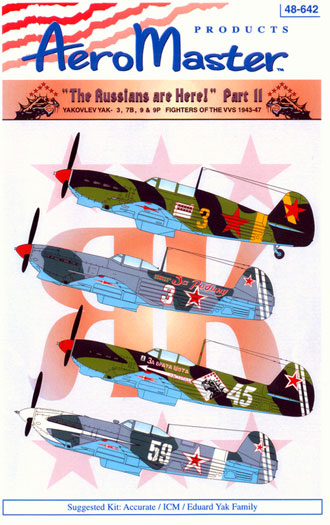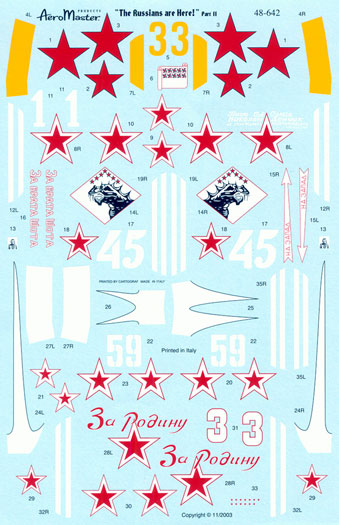|
 The
Russians are Here The
Russians are Here
Part Two
Yak-3, 7B, 9
& 9P Fighters of the VVS 1943-1947
AeroMaster
Decals
|
|
|
S u m m a r y
|
| Catalogue
Number: |
AMD 48-642 The Russians are
Here - Yak-3, 7B, 9 & 9P Fighters of the VVS 1943-1947 |
| Scale: |
1/48 |
| Contents and Media: |
Waterslide decals - Decal
sheet plus instructions and notes |
| Price: |
MSRP USD$10
available from Aeromaster's website |
| Review Type: |
FirstLook |
| Advantages: |
Perfect register; thin;
minimal carrier film; good instructions and background;
sufficient markings for all options |
| Disadvantages: |
|
| Recommendation: |
Recommended |
Reviewed
by Rodger Kelly

Aeromaster Decals' 1/48 scale The Russians are Here Part Two is
available from Squadron.com
48-642 is part 2 in AeroMaster Products series of sheets that will cover
aircraft flown by the VVS in WWII. Markings are provided for five
aircraft in a variety of camouflage schemes.
 Yak-7B,
flown by Captain Viktor Yakovlevich, the deputy Commander of 1 AE, 271
IAP, 274 IAD, Kalinin front, late 1942-43. Camouflage is AMT-6 black
and AMT-4 dark green over AMT-7 underside blue with a red spinner.
Markings consist of: Yak-7B,
flown by Captain Viktor Yakovlevich, the deputy Commander of 1 AE, 271
IAP, 274 IAD, Kalinin front, late 1942-43. Camouflage is AMT-6 black
and AMT-4 dark green over AMT-7 underside blue with a red spinner.
Markings consist of:
· A
red-outlined white scroll scoreboard with 10 swastikas crossed out in
red for the left hand side of the fuselage.
· Yellow
3 aircraft in squadron number.
· Yellow
band around the rear fuselage – supplied in two parts.
·
Yellow stripe for the fin.
· Red
star national insignia without a border for the fin/rudder and
undersides of the wings.
Yak-3, flown by Major Nikolai Fedorovich Denchik 1 AE Commander, Guards
Red Banner "Orshanskii", Order of Aleksandr Nevskii IAP, 4 GIAD, 1st
Baltic front, winter 1944. The aircraft was donation from the
Manchenkovskii Rural Soviet of Kharkov Region. Camouflage is AMT-11
grey-blue and AMT-12 dark grey upper surfaces, over AMT-7 blue
undersurfaces with a red spinner. Markings comprise:
·
White 1 plane in squadron number.
·
White donation inscription for the
fuselage.
·
Twin white stripes for the fin and
rudder.
·
National insignia consisting of white
bordered red stars in six places – fuselage, fin/rudder and undersides
of the wings.
Yak-7B, of Major Aleksandr Nikolaevich Kilaberidze, 1 AE Squadron
Commander, 65 Guards Red Banner "Orshanskii", Order of Suvorov IIIrd
Degree IAP, 4 GIAD, 1st Baltic front, October 1944. Camouflage is AMT-4
dark green AMT-6 black over AMT-7 underside blue with a red spinner and
diagonal white stripes on the fin/rudder. Markings consist of:
·
A large fierce looking dog's head on a
red-bordered white triangle with eight red stars.
·
Red bordered white arrow with the
inscription "Towards the West".
·
"For brother Shota" patriotic slogan in
white with a thin red border.
·
White 45 plane in squadron number.
·
Thin white diagonal lines for the
fin/rudder.
·
A small black and white painting of
Shota for the nose.
·
National insignia consisting of white
bordered red stars in six places.
Yak-9P, of an unknown pilot of 4 AE, 66 Guards Red Banner "Vilenskii",
Order of Suvorov IIIrd Degree IAP 4 GIAD, Perleberg Aerodrome, Germany
in 1946. Camouflage is AMT-11 grey-blue and AMT-12 dark grey over AMT-7
underside blue with a white spinner/forward fuselage, diagonal white
stripes on the fin/rudder and band around the rear fuselage. Markings
consist of:
·
The White band around the rear
fuselage.
·
White 59 plane in squadron numbers.
·
The white diagonal lines for the
fin/rudder.
·
The white forward fuselage markings –
these have a thin black border and are supplied in four separate pieces
to ease placement.
·
National insignia consisting of white
bordered (thick) red stars in six places.
Yak-9, of Senior Lieutenant Nikolai Fedorich Denchik, the Deputy
Commander of 1 AE 64 GuardsGIAD at Perlegberg aerodrome, Germany during
December 1943. Camouflage is AMT-11 grey-blue and AMT-12 dark grey over
AMT-7 underside blue with a red spinner and forward fuselage as well as
red diagonal stripes on the fin/rudder and a white bordered and darker
red arrow on the nose. Markings consist of:
·
White 3 with a thin red outline plane
in squadron numbers for the fuselage.
·
The white diagonal stripes for the
fin/rudder.
·
A red with white bordered "for the
motherland" patriotic slogan for the fuselage.
·
A scoreboard consisting of 13 red stars
with white borders.
·
White bordered national insignia in six
places.
The
decals have been printed by Cartograf, and there are sufficient markings
provided on the sheet to build each and every option. The printing is
superb with even the white borders to the tiny red stars on the last
option being in perfect register.
The
placement guide is in the form of AeroMaster’s normal A-4 size sheet
with colour side profiles of each option and appropriate top views to
show the camouflage pattern. There is short note on VVS camouflage and
paint shades that advises you that, prior to 1943, most of the VVS
camouflage schemes followed no ‘official’ templates or pattens, and that
each aircraft manufacturing factory evolved its own style. Post 1943
the industry was regulated and followed basic ‘rules’ but variations
were widespread. This is sound advice and AeroMaster’s way of telling
you to check your references before you subject your latest masterpiece
to the airbrush! The placement sheet and the decal sheet are packed in
a clear plastic zip-loc bag.
The
suggested kits are the Accurate Miniatures Yak-1B, the Eduard Yak-3 ‘Normandie-Nieman’,
the ICM Yak-9, and the Airwaves Yak-7B conversion for the ICM kit.
Another great sheet from AeroMaster but I echo their advice on checking
your references before you start!
Recommended.
Footnote
Just what does VVS, AMT-, IAP, GIAD, mean and who exactly were these
pilots? If you are keen to find out the answer to these questions as
well as how to model aircraft of the VVS take a trip to Matt Bitner's
‘Modelling the VVS 1930 – 1945 at
http://vvs.hobbyvista.com/sitenav.php an excellent site indeed!
Thanks to AeroMaster
/ Eagle Strike
Products for the review sets
On-line sales are available from the
AeroMaster Products /
Eagle Strike Productions web site.
Review TextCopyright © 2004 by
Rodger Kelly
This Page Created on 01 June, 2004
Last updated
01 June, 2004
Back to
HyperScale Main Page |
Home | What's
New | Features
| Gallery |
Reviews | Reference
| Forum
| Search